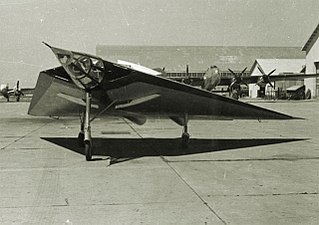
The Northrop C-19 Alpha was a series of three aircraft purchased from Northrop by the US Army Air Corps in 1931. They were slightly modified versions of the civil Northrop Alpha Type 2.

The Piper PA-15 Vagabond and PA-17 Vagabond are both two-seat, high-wing, conventional gear light aircraft that were designed for personal use and for flight training and built by Piper Aircraft starting in 1948.

The Bristol Type 170 Superfreighter Mk 32 was a larger, stretched version of the Bristol Freighter designed for Silver City Airways for use on the short air ferry routes to France.
The Auster Avis was a four-seat light aircraft developed from the Auster Autocrat. It featured a redesigned fuselage incorporating four doors and a circular cross-section towards the tail, new undercarriage, and new wing flaps. It was planned in two versions, the Mk 1 for civil use, and the Mk 2 for military and air ambulance duties. However, only two prototypes were built, and Auster abandoned the project in favour of the Auster J-5 Autocar.

The Fokker F.25 Promotor, first flown in 1946, was a single-engined, twin-boomed, four-passenger monoplane with a pusher engine mounted at the rear of a central nacelle. It was of wooden construction and has fitted with a retractable nosewheel undercarriage. One feature of the design was that instead of a 2 + 2 seating, the pilot sat in front to the left, and all three passengers were on a bench seat to the rear of him. Alternatively, when being used as an air ambulance aircraft, it could carry a patient on a stretcher, which was loaded through a hatch in the aircraft's nose. The F.25 was evocative of the pre-war G.I design. The F.25 was based upon the design of the Difoga 421 aircraft, home-built and -designed during World War II by Frits Diepen, a Ford garage owner from Tilburg, the Netherlands. His intention was to create an easy to fly personal aircraft. Due to the war an aircraft engine was not available and instead it used a Ford V-8.

The Faucett F-19 was a 1940s Peruvian eight-seat high-wing transport monoplane built by the airline Faucett Perú for its own use.

The Goodyear GA-2 Duck was a 1940s American three-seat light amphibious aircraft built by the Goodyear Aircraft Corporation. The design team included David Thurston, who later developed several other light seaplanes including the Colonial Skimmer, Lake Buccaneer, Thurston Teal and Seafire. Only 19 aircraft were built, and these were used only for testing and as demonstrators.

The Harlow PJC-2 was a 1930s American four-seat cabin monoplane, designed by Max Harlow.

The Curtiss-Wright CW-15 Sedan was a four-seat utility aircraft produced in small numbers in the United States in the early 1930s. It was a braced high-wing monoplane with conventional tailwheel landing gear with a fully enclosed cabin, superficially resembling the Travel Air 10. At the time of the CW-15's design, Travel Air had recently been acquired by Curtiss-Wright.

The Piper PT-1 was a 1940s American two-seat primary training monoplane designed and built by Piper Aircraft at Lock Haven. A low-wing tandem two-seat monoplane, the PT-1 was the first Piper aircraft to have a low-wing. It had a fabric covering over an all-metal fuselage frame and wooden spar wings and tail unit. The PT-1 had a retractable tailwheel landing gear and was powered by a 130 hp (97 kW) Franklin 6AC-2980D engine. No further aircraft were built. A four-seat development was designed as the Piper PWA-6 which did not go into production either.

The PZL-102 Kos (blackbird) is a Polish two-seat touring and training monoplane designed and built by PZL.

The FMA AeMB.2 Bombi was a bomber aircraft developed in Argentina in the mid-1930s. It was a low-wing cantilever monoplane of conventional configuration. It was fitted with fixed tailwheel undercarriage, the main units of which were covered by long, "trouser"-style fairings. The initial AeMB.1 configuration was fitted with a dorsal machine gun turret, later removed from the AeMB.2 to improve stability. Fifteen production examples saw service with the Argentine Air Force between 1936 and 1945. Two were lost to air accidents.

The FMA AeT.1 was an airliner built in Argentina in the early 1930s. It was a low-wing cantilever monoplane of conventional design, with fixed tailwheel undercarriage. Only three examples were built, christened General San Martín, Deán Funes, and Jorge Newbery. These aircraft provided Argentina's first scheduled airline services with Aero-Argentina, flying between Córdoba and Buenos Aires. The Deán Funes was also used to make a long-distance flight to Ushuaia, bringing the first mail to that town after a flight of 6,500 km (4,000 mi). Air France director Colin Jeannel flew as a passenger on that flight.

The FMA AeC.2 was a light utility aircraft built in Argentina in the early 1930s, and also produced as a military trainer and observation aircraft under the designations AeME.1, AeMO.1, AeMOe.1 and AeMOe.2.
The FMA AeC.3 was a light utility aircraft built in Argentina in 1934; a further development in the series of designs that had originated with the AeC.1 three years previously. Deliveries to Argentina's aeroclubs were made late in the year.

The Douglas DF was a commercial flying boat built by Douglas Aircraft Company, first flown on 24 September 1936.

The FMA I.Ae. 37 was a prototype jet fighter developed in Argentina during the 1950s. It never flew and was cancelled in 1960.

The I.Ae.41 Urubú was a two-seat flying wing tailless glider, built in Argentina by the Fábrica Militar de Aviones (FMA) in the 1950s.

The Curtiss CA-1 was an American five-seat biplane amphibian designed by Frank Courtney and built by Curtiss-Wright at St Louis, Missouri.
The Yakovlev AIR-11, also known as Yakovlev LT-1, was a 3-seat low-wing touring cabin monoplane designed by A.S. Yakovlev in the USSR, circa 1936.

















